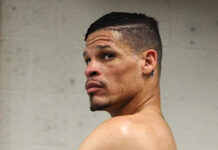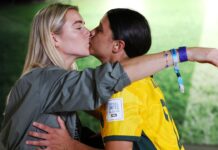June 10, 2021
As part of a series of articles to mark Pride Month, artistic swimmer Stephanie Ramsay shares her experiences as a member of the LGBTQ+ community within aquatics.
Stephanie has been competing for the last five years with Out To Swim, the UK’s largest LGBTQ+ aquatics club and charity.
The club was founded in 1992 and has since gone on to attend competitions across the country and internationally.
Her love for and involvement with the club saw her take on the role as chair of the artistic swimming section shortly before the first UK lockdown in 2020.
Here, Stephanie explains why the community aspect of Out To Swim is so important, why she loves being part of a mixed artistic swimming team and what she thinks will be the role of LGBTQ+ clubs in the future.
Five years with Out To Swim
I joined Out To Swim back in 2016, not realising it was an LGBTQ+ club – I missed a lot of rainbows on the way in!
I came back into the sport after injury and saw it was a fantastic community, so I stayed around and ended up becoming chair just as the pandemic hit, so this is my second year in that role.
I’ve just loved being part of this club. As we are one of the few mixed clubs, and certainly one of the few mixed Masters artistic swimming clubs in the country, our aim is just to try to get as many people into artistic swimming as we can – and as many people of different genders into the sport to open it up.
It has been very much a white girls’ sport and it can be quite difficult to get into, so it’s about trying to open it up to as many people as possible.
All about the community
It seems like it would be a nice idea at some point to not need to have specifically gay, LGBTQ+ swim clubs or sports clubs in general – and when you look at Nationals, you see that we are a much better part of that wider swimming community now. Perhaps it is less essential.
But it’s about so much more than just an LGBTQ+ swim team, it’s that whole community that comes together, those shared experiences that you don’t necessarily get in a ‘straight’ club.
It’s where you can wear all your identities at once. It’s quite an interesting position to be in, to be part of a club where we are minorities within minorities within minorities.
Artistic swimming is such a small part of the aquatics community anyway. You then have adult beginners who are male, and we account for about 90 per cent of that particular population, all in one club.
That means we definitely have a lot of members who know what it’s like to be on the outside of a community – and when you’ve been there, I guess you just don’t want other people to be in the same situation, so let’s get people to be somewhere where they are comfortable.
I was lucky enough to win a Club Spirit Award at the Out For Sport awards earlier this year. That was really quite special.
Our swimmers are primarily queer of some variety. In our artistic swimmers, we have a much larger straight percentage. That’s because we have people that have come in with really strong backgrounds, who have been competing at national level within their own country.
They have trialled at other clubs and they’ve ultimately come back to us because we had created that community that they wanted to be part of. That was pretty special, to have heard that from a few people now.

The enthusiasm is ‘amazing’
From my perspective, I have lived quite a blessed gay life in that I’ve very rarely encountered any sort of homophobia. But one of the few times I’ve encountered it has been at an artistic swimming competition when they turned around and said, ‘you’re swimming with them?!’
To this day, I still don’t know whether it was, ‘why are you swimming with the gay club?’, ‘why are you swimming with the boys?’ or ‘why are you swimming with somebody who’s not as big a competitor at nationals?’
I have my views, I know which way it felt. So to have seen a little bit of that side of aquatics, to then have people who aren’t necessarily in that minority come in and say, ‘we just want to be part of this, we absolutely want to represent this club, we want to take it as far as we can and be involved and do all this’ – that is amazing.
Again, we’ve got a whole bunch of adult beginners, some are queer, some aren’t. To just be able to give that opportunity and see people really enthusiastic and then recommending it to their friends and then building on that, it’s great to see.
After all, the restrictions of lockdowns over the last 15 months, people are happy to be back as well!
Pride in Water involvement
Since the LGBTQ+ support network
I think there is always going to be a need for LGBTQ+ sports clubs and that sort of thing, but it shouldn’t be the only place where you feel comfortable to be out as an athlete.
To have that universal acceptance would be a dream.







